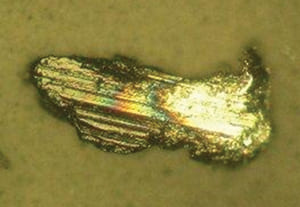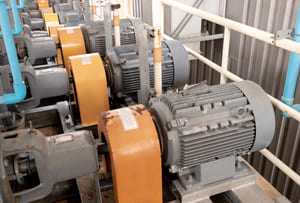4 Key Elements for Interpreting an Oil Analysis Report

Years ago, a customer came into my office, visibly upset. He had just received his second oil analysis report for one of his Caterpillar gas engines. The report came back from the laboratory “red” because of a high level of copper found in the analysed lubricant sample. His first report had suffered the same fate, reporting back with around 120 ppm, even though the engine was under 2,000 total operating hours.
Much of the customer’s anger was because after receiving the second red report, he made the call to stop the engine, dismount it, and inspect the bearings. When he did this, he couldn’t see any reason for alarm. Unfortunately, this customer’s facility was a power plant that produced electricity for its customers, so stopping one engine had serious consequences, including a loss in productivity, wasted manpower and time, and an increased risk of injury. His anger was understandable.
Did You Know?
Across every industry, one hour of downtime costs an average of $260,000.Source: Aberdeen
We informed him that a red oil analysis report is generally an early warning sign that something is occurring within the engine, but that doesn’t necessarily mean that you should open it up. You need to understand the report and consider all the parameters, not just one.
Because of the customer’s lack of training, he was expecting to see wear materials in the engine or signs of wear on the bearings. When it wasn’t there, he assumed nothing was wrong with his machine. We knew, considering the age of the machine, that not only would wear appearing on the engine be improbable, but that his deficient knowledge had led him to make the wrong call and shut down his machine unnecessarily.
In this article, I will highlight various points of ignorance I have noticed throughout my career concerning reading and understanding an oil analysis report. If these misconceptions are not corrected, the benefits of an oil analysis program will be negated, and the program will only serve to waste time and money.
Interpreting an oil analysis report is a science, and technicians and engineers must be trained to read them properly and consider all of the parameters. This will help accurately assess:
- The health of the machine (wear metals).
- The health of the lubrication system (contamination).
- The health of the lubricant.
Below are four elements our customer needed to understand in order to interpret his oil analysis report.
1 – The PPM Scale
 The concentrations of wear metals and additives in lubricants are given in parts per million (ppm), which corresponds to milligrams per litre (mg/L). Since chemical elements do not have the same density, two elements with the same concentration can have different volumes of wear. One ppm is equivalent to the absolute fractional amount multiplied by one million.
The concentrations of wear metals and additives in lubricants are given in parts per million (ppm), which corresponds to milligrams per litre (mg/L). Since chemical elements do not have the same density, two elements with the same concentration can have different volumes of wear. One ppm is equivalent to the absolute fractional amount multiplied by one million.
A better way to think of ppm is to visualize putting four drops of ink in a 55-gallon barrel of water and thoroughly mixing it. This procedure would produce an ink concentration of 1 ppm. Some other analogies that may help with visualizing the scale involved with one ppm include:
- One millimetre in one kilometre.
- One minute in two years.
- One second in 11.5 days.
For our case, a concentration of 100 ppm roughly corresponds to 0.0115 cm3 of copper in one litre of lubricant; this is about 4 microns thickness on a bearing of a 37-litre oil sump engine if we suppose that all the copper present in the oil only comes from a bearing, which is not the case since there are many bearings and other sources of copper in the engine.
The question now is, is it possible to see 4-micron-thickness wear with our naked eye?
The answer is no; the limit of our vision is around 40 microns. In conclusion, a 100-ppm concentration due to wearing metal is generally unnoticeable to the human eye.
2 – Elemental Analysis
 Two different methods are used for elemental analysis – the Inductively Coupled Plasma (ICP) Spectrometer (ASTM D- 5185) and the Rotating Disk Emission (RDE) Spectrometer (ASTM D 6595). Both instruments use a high-energy source to excite atoms within a sample.
Two different methods are used for elemental analysis – the Inductively Coupled Plasma (ICP) Spectrometer (ASTM D- 5185) and the Rotating Disk Emission (RDE) Spectrometer (ASTM D 6595). Both instruments use a high-energy source to excite atoms within a sample.
Elemental Analysis
A test designed to determine the presence of elements in an oil, such as wear metals, contaminants, and oil additives.
Source: Machinery Lubrication
The atoms do not want to be in this excited state, and as energy is reduced, they produce light energy. The emitted light energy is specific to each atom. Therefore, the amount of light energy can be converted to the concentration of each tested element.
The RDE can vaporize particles up to 10 um, while the ICP can vaporize particles up to 5 um depending on the sample preparation.
In all cases, wear metal sizes are under 40 microns.
3 – Sources of Copper
 The source of copper in an oil analysis report is not limited to only bearings. If it was from the bearing, we would have also had other materials, such as tin or lead, since the bearing’s surface was alloy. This was not the case; the report only mentioned a high level of copper and all other elements were at normal levels.
The source of copper in an oil analysis report is not limited to only bearings. If it was from the bearing, we would have also had other materials, such as tin or lead, since the bearing’s surface was alloy. This was not the case; the report only mentioned a high level of copper and all other elements were at normal levels.
However, cooler core leaching is a chemical process that has been well-documented as a source of high concentrations of copper.
For new engines with less than 1,500 hours of service life, the cooler core becomes an active reaction site for the zinc dialkyldithiophosphate (ZDDP), resulting in copper sulfides forming on the copper cooler tubes. These sulfides later come off in the oil, contributing to a rising copper concentration that can reach well over 300 ppm. This concentration will become normal when the cooler reaches equilibrium, and this level of copper is generally not dangerous.
4 – Wear Metal Levels Can Stabilize
 With our customer, his second oil analysis report was conducted to confirm the results from the first report. The only way the concentration of the wear elements would decrease would be if the engine received a top-off with fresh oil. Since our customer confirmed he did not perform a top-off, one would expect to see an increase in wear materials. However, this was not the case.
With our customer, his second oil analysis report was conducted to confirm the results from the first report. The only way the concentration of the wear elements would decrease would be if the engine received a top-off with fresh oil. Since our customer confirmed he did not perform a top-off, one would expect to see an increase in wear materials. However, this was not the case.
The difference in concentration between the first and second samples were insignificant, meaning that the production of copper was stabilizing. This confirmed for us that his problem was the result of a cooler core leaching phenomenon in his engine.
Conclusion
Many great leaders over the past decades have proclaimed, “If you think that education is expensive, try ignorance.” Indeed, ignorance is dangerous and can even turn a good program, which should be beneficial to a company, into a great source of annoyance and declining productivity.
Let’s take education very seriously and ensure that everyone involved in the process of interpreting an oil analysis is trained and certified. This will help companies realize the exceptional benefits that come from a quality oil analysis program.
